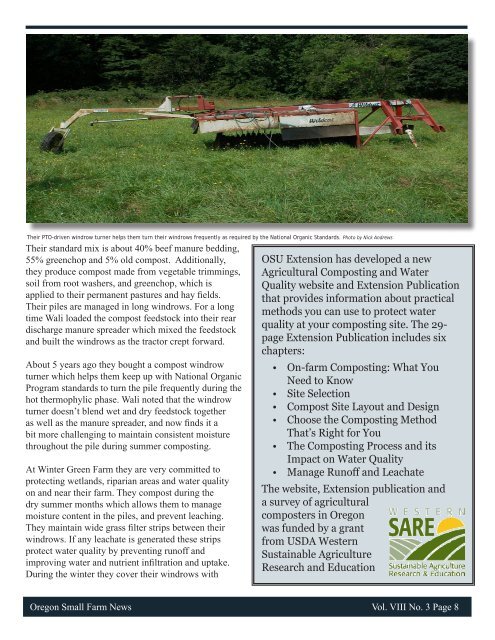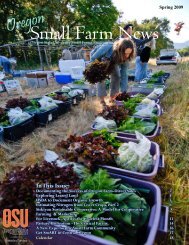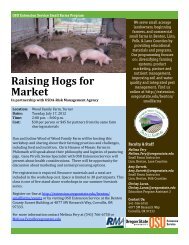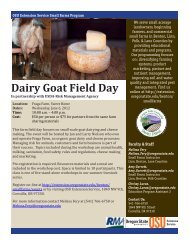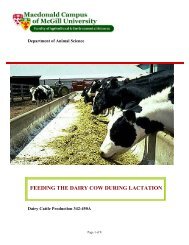Small Farm News - Oregon Small Farms - Oregon State University
Small Farm News - Oregon Small Farms - Oregon State University
Small Farm News - Oregon Small Farms - Oregon State University
Create successful ePaper yourself
Turn your PDF publications into a flip-book with our unique Google optimized e-Paper software.
Their PTO-driven windrow turner helps them turn their windrows frequently as required by the National Organic Standards. Photo by Nick Andrews<br />
Their standard mix is about 40% beef manure bedding,<br />
55% greenchop and 5% old compost. Additionally,<br />
they produce compost made from vegetable trimmings,<br />
soil from root washers, and greenchop, which is<br />
applied to their permanent pastures and hay fields.<br />
Their piles are managed in long windrows. For a long<br />
time Wali loaded the compost feedstock into their rear<br />
discharge manure spreader which mixed the feedstock<br />
and built the windrows as the tractor crept forward.<br />
About 5 years ago they bought a compost windrow<br />
turner which helps them keep up with National Organic<br />
Program standards to turn the pile frequently during the<br />
hot thermophylic phase. Wali noted that the windrow<br />
turner doesn’t blend wet and dry feedstock together<br />
as well as the manure spreader, and now finds it a<br />
bit more challenging to maintain consistent moisture<br />
throughout the pile during summer composting.<br />
At Winter Green <strong>Farm</strong> they are very committed to<br />
protecting wetlands, riparian areas and water quality<br />
on and near their farm. They compost during the<br />
dry summer months which allows them to manage<br />
moisture content in the piles, and prevent leaching.<br />
They maintain wide grass filter strips between their<br />
windrows. If any leachate is generated these strips<br />
protect water quality by preventing runoff and<br />
improving water and nutrient infiltration and uptake.<br />
During the winter they cover their windrows with<br />
OSU Extension has developed a new<br />
Agricultural Composting and Water<br />
Quality website and Extension Publication<br />
that provides information about practical<br />
methods you can use to protect water<br />
quality at your composting site. The 29-<br />
page Extension Publication includes six<br />
chapters:<br />
• On-farm Composting: What You<br />
Need to Know<br />
• Site Selection<br />
• Compost Site Layout and Design<br />
• Choose the Composting Method<br />
That’s Right for You<br />
• The Composting Process and its<br />
Impact on Water Quality<br />
• Manage Runoff and Leachate<br />
The website, Extension publication and<br />
a survey of agricultural<br />
composters in <strong>Oregon</strong><br />
was funded by a grant<br />
from USDA Western<br />
Sustainable Agriculture<br />
Research and Education<br />
<strong>Oregon</strong> <strong>Small</strong> <strong>Farm</strong> <strong>News</strong> Vol. VIII No. 3 Page 8


